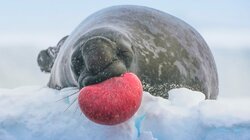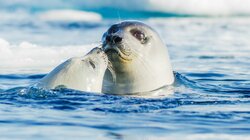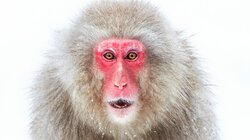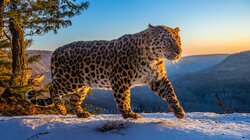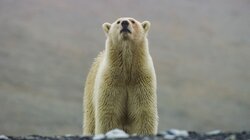Frozen Planet IIA fagy birodalma 2

Befejezett / kaszált 2022.09 - 2022.09 | 60 perc @BBC One , GB
Galéria David Attenborough (Presenter)
Természet, Rövid-sorozat, Dokumentum
Honlap | IMDb | SorozatJunkie | TV Maze | TMDB
09.11.
21:00
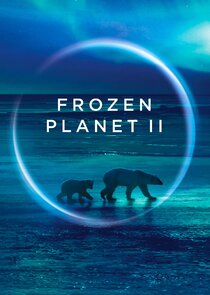
Epizód adatlap | SorozatJunkie | IMDb | Hozzászólások (0) |
Journeying from pole to pole, we reveal the surprising frozen worlds that exist across the planet and the remarkable animals that make them their home.
We begin our journey in the far south, in the most hostile place on earth, the frozen continent of Antarctica. After being raised on the ice in winter, emperor penguin chicks find themselves abandoned by their parents in spring. To survive, they must find their own way across the treacherous sea ice to the rich waters of the Southern Ocean.
The waters surrounding Antarctica may be the richest of all, but they are also home to an exceptionally sophisticated predator, the killer whale. To reach their favoured prey, Weddell seals, a family of killer whales have learnt to generate their own waves, washing the seals off their ice floes. It's a technique that has been passed down over generations and is coordinated by the family matriarch, who can be over 100 years old.
Leaving Antarctica and travelling north, we discover frozen habitats that are created by altitude. The greatest of these is the Himalaya, the tallest mountain range on earth, which contains so much ice and snow it is known as the third pole. In the shadow of the Himalaya lies a vast frozen grassy plain that is home to the fluffiest cat in the world, Pallas's cat. It may have extremely dense fur, but if it's to survive the Mongolian winter, it needs to catch lots of gerbils and voles. Easier said than done when you only have short legs and paws that are sensitive to the cold.
North of the Great Steppe lies the boreal forest, which encircles the continents of North America, Europe and Asia, and remains frozen for six months of the year. Prowling these forests in the far east of Russia is the Siberian tiger, the largest cat in the world. In winter, it is on the lookout for black bears hibernating in caves, a high-risk strategy that only a cat of this size would attempt.
Above the boreal forest, we cross into the Arctic Circle, where conditions become so extreme that trees can no longer grow. This is the tundra. Living here are relics of the last ice age, musk ox. In spring, their calves face a far greater danger than the cold, grizzly bears. Encounters can be brutal, but if just a few calves survive the gauntlet, the herd's future is secure.
To the north of the tundra is the Arctic Ocean, the only ocean that can completely freeze over. Living here is one of the most peculiar animals on earth, the hooded seal. Males have extraordinary inflatable noses, producing a bright red balloon out of their left nostrils. One male hopes this will make him irresistible.
All of the frozen habitats share one thing in common: the threat posed by today's climate change. Travelling to the island of Greenland, home to the largest body of ice in the northern hemisphere, we witness how global warming is melting its ice cap at faster rates than ever before, with profound consequences for global sea levels. Lastly, we visit the Arctic's most iconic resident, the polar bear, as a mother bear struggles to provide for her cubs in a world of shrinking sea ice.
09.18.
21:05

Epizód adatlap | SorozatJunkie | IMDb | Hozzászólások (0) |
At the top of our planet lies a magical realm, the Arctic Ocean. After four months of winter darkness, the sun returns to reveal a frozen ocean covered in ice. Mother polar bears emerge from their hillside dens and lead their cubs down to the sea ice to hunt, while a young male and female bear forge a surprising friendship out on the ice.
For others, the frozen sea is a trap. A pod of beluga whales has been confined to an ice hole for five months, slowly starving to death as the food around them runs out. Their salvation lies in the strengthening sun that comes with spring, melting the sea ice, allowing their escape.
Off the east coast of Greenland, the floating pack ice in spring is a nursery ground for harp seals. Mothers and pups have just a few weeks together for the pup to learn to swim before she leaves him to fend for himself. But in today's warming climate, storms can tip helpless youngsters into the sea before they are strong enough to fend for themselves.
Summer is a time of plenty in the Arctic Ocean as plankton blooms feed millions of tiny mouths, such as bizarre skeleton shrimps, as well as the biggest: bowhead whales. These ancient and long-lived whales arrive en masse every year at secret locations known as whale spas. But today, with the loss of summer sea ice, their peace is shattered by orcas from the south. These daring predators are bold enough to take on the much larger bowheads, targeting their vulnerable calves.
The 24-hour daylight of the Arctic summer attracts visitors from afar, including huge flocks of seabirds like crested auklets. A male must use both his song and a secret tangerine perfume if he is to attract a mate. For the resident walrus, the summer heat can be unbearable. After hauling himself to the beach to moult, an old male uses an ingenious technique to get himself back to the cool of the water - a roly-poly!
Summers in the Arctic today bring record-breaking heat. With climate change, it is warming faster than anywhere else on Earth. It is predicted that the Arctic Ocean could become ice-free each summer by 2035, raising new challenges for polar bears. Without sea ice, more and more bears are becoming stranded on remote Arctic islands. It's a dangerous place to be for a mother bear with cubs, surrounded by larger, predatory males.
09.25.
21:00

Epizód adatlap | SorozatJunkie | IMDb | Hozzászólások (0) |
Mountains create frozen habitats on every continent on Earth, and each of these high-altitude worlds holds unique challenges for its surprising and remarkable life.
We begin our journey close to the equator - the furthest point from the poles - in East Africa. Here on the high slopes of Mount Kenya, during the day the tropical sun keeps the cold at bay, but at night the frost descends. During this cycle of freeze and thaw, a pregnant high-casqued chameleon must choose the right time to give birth if her newborns are to escape the deadly night freeze.
Away from the equator in the European Alps, long cold winters give way to short, bountiful summers. For a pair of golden eagles raising their chick, the demand to provide enough food for it drives them to tackle prey five times their size. To catch a goat-like chamois, they risk it all using one of the most daring and breathtaking hunting techniques ever witnessed.
The mountains of Japan are the snowiest place on earth, providing hostile conditions for a lone male macaque cast away from his troop. His only chance of survival comes with finding another male whose embrace will provide him with life-saving warmth. But in the frozen peaks, the deadliest force is an avalanche whose full destructive power is captured for the first time using high-speed camera racer drones.
The roof of the world is home to an array of unexpected cold-loving creatures. In the remote Southern Alps of New Zealand, a species of parrot - the kea - uses its famed intelligence to feed on the dead. And in the Andes in South America, flamingos thrive in high-altitude volcanic lakes, but their chicks must race to escape the winter freeze or risk becoming trapped in the ice.
Today, due to climate change, our frozen peaks are undergoing rapid change. Using groundbreaking time-lapse photography, we reveal mountain glaciers vanishing before our very eyes and discover what a warming world may mean for our most famous mountain resident of all, the giant panda.
10.02.
21:00

Epizód adatlap | SorozatJunkie | IMDb | Hozzászólások (0) |
Antarctica is the most hostile of all Earth's frozen worlds. Yet even here, amongst some of the most challenging conditions on the planet, life finds a way not just to survive, but thrive.
Our journey begins at the far edge of the continent, on its far-flung sub-Antarctic islands. Here we meet king penguins that, to feed at sea, must face the danger of ferocious leopard seals lurking in the shallows. On another island, we witness for the first time male Antipodean wandering albatross partnering up with each other as the females in their population are disappearing due to fishing activity.
Heading towards the continent of Antarctica, we traverse the roughest seas on earth - the Southern Ocean - where we find the rarely filmed Antarctic blue whale, the largest animal to have ever lived. At the edge of Antarctica, the sea is so cold that it freezes over, creating a vital ice platform for a mother Weddell seal to raise her precious pup. Still, she needs to protect him from aggressive males.
In spring, the coast of Antarctica is free of snow, drawing in thousands of breeding chinstrap penguins. Stones are at a premium to build their elevated nests and protect chicks from meltwater. But stealing is commonplace, and to make matters worse, with climate change we find chicks today shivering with hypothermia – a warming Antarctica means increased meltwater. Other residents are facing an uncertain future too, including wave-washing killer whales. We discover that their favourite prey, Weddell seals, are now harder to reach, so instead they are resorting to targeting much more feisty prey, including leopard seals, an apex predator in its own right. This dramatic encounter has never been filmed before.
Travelling into the interior of the continent - into the frozen heart of Antarctica - we find great surprises. This is one of the most volcanic regions on earth, and one of the driest. We reveal unexpected sand dunes, hidden in a rare ice-free valley. Then, on the exposed mountain tops, sticking out from the otherwise ice-covered interior, we find tiny snow petrels, which raise their chicks further south than any other bird, and defend their territory by projectile vomiting!
The greatest revelation lies deep in the interior, beneath the surface of an ice-covered lake, where we discover ancient alien-like structures - giant stromatolites - built by primitive lifeforms. If life can make it here, in the extremes of Antarctica, it raises the possibility that life can exist elsewhere, including in the frozen lakes of distant planets.
10.09.
21:00

Epizód adatlap | SorozatJunkie | IMDb | Hozzászólások (0) |
In the far north of our planet lies the largest land habitat on earth, home to snow-covered forests and the icy open tundra. These are lands of extremes that push animals to their limits: in winter they are so cold that much of the ground has remained frozen since the last ice age. To stand any chance of survival, animals must adapt in extreme ways: here a super pack of wolves, 25 strong, has come together to take on the only large prey available to them in winter, American bison.
On the featureless tundra, an Arctic fox must strike a living alone. She is a wanderer and will roam many hundreds of miles searching for tiny lemmings, hidden deep underground. The only way to reach them is with a head dive. In the remote far east of Russia, a rare Amur leopard prowls the seemingly empty, snow-covered forest. With little prey available, it must use its ingenuity to find a meal. It follows crows in the hope of finding carrion, but it must not stay long, for it shares the forest with a far larger but equally hungry big cat, the Siberian tiger.
As spring arrives, the forests begin to thaw and life returns. Beneath the ground, a nest of tiny painted turtle hatchlings now emerge, having remained frozen in a state of suspended animation throughout winter. To the north, it is a further month before the sun's warmth baths the frozen ground of the tundra. Tucked away underground lies a tiny snow queen – a Lapland bumble bee. She is the sole survivor of her colony - the rest perished in the winter freeze - but her larger size, her furry body and antifreeze in her blood have allowed her to survive. Now she is in a hurry. She must feed herself and raise a brood in the brief window of summer while the flowers are in bloom.
Snowy owls also use the open tundra to breed: one pair have raised a nest full of fluffy chicks. With 24-daylight in which to hunt, the dedicated parents bring back meal after meal for their ever-growing brood. But one day, they return to find the nest empty…
Today, the biggest challenge in the tundra is climate change. Warming summers are melting the permafrost deep within the soil, causing the ground to thaw and, in places, the land to collapse. These changes are impacting the animals too. Caribou arrive in herds of 200,000 individuals to raise their calves in the rich pastures, but warming means mosquitos emerge sooner and bother the calves before they've had a chance to gain strength. The parents drive their young to cooler, mosquito-free land, but to get there they must cross rivers running with increased meltwater and escape hungry grizzly bears. They, like much of the tundra's wildlife, are adapted to live in the extremes - but the challenge of today's warming climate could be one extreme too many.
10.16.
21:00

Epizód adatlap | SorozatJunkie | IMDb | Hozzászólások (0) |
Our frozen planet is changing. In this final episode, we meet the scientists and people dedicating their lives to understanding what these changes mean, not just for the animals and people who live there, but for the world as a whole.
Our journey begins in the Arctic, where every summer huge quantities of ice calve from the edges of Greenland's melting glaciers. On top of the ice cap itself, glaciologist Alun Hubbard descends into a moulin to try to understand the mechanisms that are driving this historic loss of ice.
Elsewhere in the Arctic, it's not just land ice that is disappearing. In the Gulf of St Lawrence, Canada, biologists are trying to find out how the loss of sea ice will impact the lives of baby harps. In Arctic Russia, with the loss of summer sea ice, more and more polar bears are arriving on the island of Wrangel. Here, a local ranger and scientists are braving the hungry bears to assess their future survival.
Loss of sea ice impacts not just wildlife but people too. In the remote community of Qaanaaq, Greenland, local Inuit hunters are finding the ice too dangerous to travel and hunt on, risking their traditional way of life. And these changes happening in the Arctic have the potential to affect people far beyond. On Alaska's open tundra, bubbling lakes hint at the gases being released from the previously frozen soil, including the potent greenhouse gas methane.
There is one place where the full scale of a melting Arctic can be best witnessed - from space. Based in the International Space Station, astronaut Jessica Meir looks down at forest fires across Europe and reflects how our changing weather patterns are interconnected.
Rapid ice loss is also happening across the high mountains of the planet's continents. Glaciologist Hamish Pritchard uses a sophisticated helicopter-strung radar system to try to quantify how much ice is left in the previously uncharted glaciers of the Himalayas. It's important as, downstream, some 1.2 billion people rely on glacial meltwater as their primary source of fresh water.
Finally, in Antarctica, we meet Bill Fraser, who has dedicated 45 years of his life to studying the Adelie penguin. Over this period, he has witnessed changes in weather conditions and the extinction of entire colonies. These ‘canaries in the coal mine' are a sign that all is not well, even in the remotest place on earth. And changes here have the potential to affect all of us, so an international group of scientists is on an urgent mission to assess the stability of a huge body of ice known as the Thwaites ice shelf. If this plug of ice melts and slips into the ocean, it will raise global sea levels, impacting coastal communities across the planet.
The unprecedented changes our scientists are witnessing may be profound, but there is hope that, through a combination of technology and willpower, there is still time to save what remains of our frozen planet.
